The contribution of Notch1 to nephron segmentation in the developing kidney is revealed in a sensitized Notch2 background and can be augmented by reducing Mint dosage
- PMID: 19914235
- PMCID: PMC2812695
- DOI: 10.1016/j.ydbio.2009.11.017
The contribution of Notch1 to nephron segmentation in the developing kidney is revealed in a sensitized Notch2 background and can be augmented by reducing Mint dosage
Abstract
We previously determined that Notch2, and not Notch1, was required for forming proximal nephron segments. The dominance of Notch2 may be conserved in humans, since Notch2 mutations occur in Alagille syndrome (ALGS) 2 patients, which includes renal complications. To test whether mutations in Notch1 could increase the severity of renal complications in ALGS, we inactivated conditional Notch1 and Notch2 alleles in mice using a Six2-GFP::Cre. This BAC transgene is expressed mosaically in renal epithelial progenitors but uniformly in cells exiting the progenitor pool to undergo mesenchymal-to-epithelial transition. Although delaying Notch2 inactivation had a marginal effect on nephron numbers, it created a sensitized background in which the inactivation of Notch1 severely compromised nephron formation, function, and survival. These and additional observations indicate that Notch1 in concert with Notch2 contributes to the morphogenesis of renal vesicles into S-shaped bodies in a RBP-J-dependent manner. A significant implication is that elevating Notch1 activity could improve renal functions in ALGS2 patients. As proof of principle, we determined that conditional inactivation of Mint, an inhibitor of Notch-RBP-J interaction, resulted in a moderate rescue of Notch2 null kidneys, implying that temporal blockage of Notch signaling inhibitors downstream of receptor activation may have therapeutic benefits for ALGS patients.
Copyright 2009 Elsevier Inc. All rights reserved.
Figures
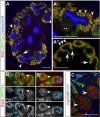
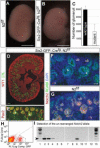
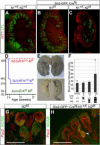
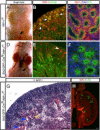
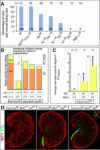
Similar articles
-
Notch2 activation in the embryonic kidney depletes nephron progenitors.J Am Soc Nephrol. 2010 May;21(5):803-10. doi: 10.1681/ASN.2009040353. Epub 2010 Mar 18. J Am Soc Nephrol. 2010. PMID: 20299358 Free PMC article.
-
Notch2, but not Notch1, is required for proximal fate acquisition in the mammalian nephron.Development. 2007 Feb;134(4):801-11. doi: 10.1242/dev.02773. Epub 2007 Jan 17. Development. 2007. PMID: 17229764 Free PMC article.
-
p53 Enables metabolic fitness and self-renewal of nephron progenitor cells.Development. 2015 Apr 1;142(7):1228-41. doi: 10.1242/dev.111617. Development. 2015. PMID: 25804735 Free PMC article.
-
Stem cells in the embryonic kidney.Kidney Int. 2008 Apr;73(8):913-7. doi: 10.1038/sj.ki.5002784. Epub 2008 Jan 16. Kidney Int. 2008. PMID: 18200005 Review.
-
Molecular insights into segmentation along the proximal-distal axis of the nephron.J Am Soc Nephrol. 2007 Jul;18(7):2014-20. doi: 10.1681/ASN.2007040453. Epub 2007 Jun 13. J Am Soc Nephrol. 2007. PMID: 17568016 Free PMC article. Review.
Cited by
-
Notch signaling promotes nephrogenesis by downregulating Six2.Development. 2016 Nov 1;143(21):3907-3913. doi: 10.1242/dev.143503. Epub 2016 Sep 15. Development. 2016. PMID: 27633993 Free PMC article.
-
Revisiting the role of Notch in nephron segmentation confirms a role for proximal fate selection during mouse and human nephrogenesis.Development. 2022 May 15;149(10):dev200446. doi: 10.1242/dev.200446. Epub 2022 May 16. Development. 2022. PMID: 35451473 Free PMC article.
-
WT1 and kidney progenitor cells.Organogenesis. 2010 Apr-Jun;6(2):61-70. doi: 10.4161/org.6.2.11928. Organogenesis. 2010. PMID: 20885852 Free PMC article. Review.
-
The extracellular domain of Notch2 increases its cell-surface abundance and ligand responsiveness during kidney development.Dev Cell. 2013 Jun 24;25(6):585-98. doi: 10.1016/j.devcel.2013.05.022. Dev Cell. 2013. PMID: 23806616 Free PMC article.
-
β-catenin regulates the formation of multiple nephron segments in the mouse kidney.Sci Rep. 2019 Nov 4;9(1):15915. doi: 10.1038/s41598-019-52255-w. Sci Rep. 2019. PMID: 31685872 Free PMC article.
References
-
- Bai S, Kopan R, Zou W, Hilton MJ, Ong CT, Long F, Ross FP, Teitelbaum SL. Notch1 regulates osteoclastogenesis directly in osteoclast precursors and indirectly via osteoblast lineage cells. J Biol Chem. 2007;283:6509–6518. - PubMed
-
- Boyle S, Misfeldt A, Chandler KJ, Deal KK, Southard-Smith EM, Mortlock DP, Baldwin HS, de Caestecker M. Fate mapping using Cited1-CreERT2 mice demonstrates that the cap mesenchyme contains self-renewing progenitor cells and gives rise exclusively to nephronic epithelia. Dev Biol. 2008;313:234–245. - PMC - PubMed
-
- Chen L, Al-Awqati Q. Segmental expression of Notch and Hairy genes in nephrogenesis. Am J Physiol Renal Physiol. 2005;288:F939–952. - PubMed
-
- Cheng H, Miner J, Lin M, Tansey MG, Roth KA, Kopan R. g-Secretase Activity is Dispensable for the Mesenchyme-to-Epithelium Transition but Required for Proximal Tubule Formation in Developing Mouse Kidney. Development. 2003;130:5031–5041. - PubMed
Publication types
MeSH terms
Substances
Grants and funding
LinkOut - more resources
Full Text Sources
Other Literature Sources
Molecular Biology Databases
Research Materials
Miscellaneous

